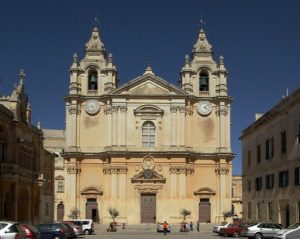This is thought to have been built on the site of a Roman Villa belonging to Publius where St Paul healed the Governor’s father and converted Publius to Christianity. The original building was destroyed in the 1693 earthquake and the present building was finished 1702. It has a simple facade with two bell towers and two clock faces. One tells time, the other the date. The red dome is visible across much of Malta, but not from the front of the church.
Tickets are bought from the museum, across the square from the cathedral in the 18thC palace. This has now extended into another building next door. We skipped the museum having read it was a collection of coins, silver plate, manuscripts and religious paintings.
Entry to the Cathedral is through the side door where the person checking tickets was more concerned about talking to a colleague than welcoming visitors. Not the best of starts.
The inside of the Cathedral was covered in red damask drapes which were being hung up using a cherry picker. These are put up twice a year at Christmas and for Corpus Christi and the festival of St Peter and St Paul. They are then removed and put away again.
The floor is covered with marble memorial stones, some quite recent. Many had cardinals hat.
The nave is lined with massive round arches flanked with pillars of red marble flecked with white. The carved tops are painted gold. Grey and gold bands above form a border above the arches. The wooden pulpit has a small carved wooden crucifix standing on it and there are wooden confessionals scattered around the cathedral. Windows in the nave and dome are plain glass with elaborately carved gold canopies over them.
The side aisles are made of sandstone blocks with plain domes and a series of side altars. In May 2012, work was being done on the nave ceiling and part was boarded over. The rest of the nave ceiling and the dome are covered in paintings.
There is a small plain mass table with large altar behind with silver candlesticks and a canopy suspended above. Behind this are wooden choir stalls and a big wooden stand for holding the choral book with music. The rounded apse is a survival from the original church with paintings of St Paul’s shipwreck on Malta on the way to face trial in Rome. On the back wall is a large painting of the conversion of St Paul.
There are large altars at the ends of the side transepts. These have a smaller chapel off on either side of the chancel. There are organs above the entrances to both. The right hand chapel was shut off by iron grille gates. Those on the left, Chapel of Blessed Sacrament, were open. This has a beautiful decorative silver front to the altar and a large silver box for the host. Above is a small 13thC icon of the Virgin and Child in a very decorative frame. The walls are covered with red and gold patterned damask. The ceiling is grey and gold with paintings.
The Chapel of Blessed Sacrament was delightful and made the visit worthwhile. Apart from this we were slightly disappointed by the church which lacked the impact of many of the other churches we had visited.








